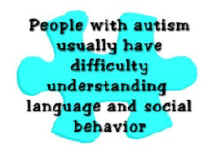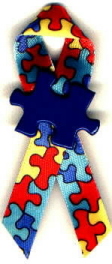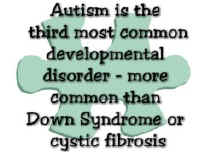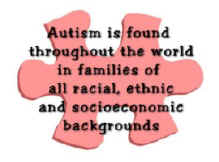| Matt Knits |
 |
 |
 |
Autism
Links 
Have you ever wondered what the term "autism" or "autistic disorder" means?
Statistics currently indicate that "1 in every 36 children in the U.S. are diagnosed with autism." (Source: CDC)
According to MSN Encarta, autism is a “disorder that severely impairs development of a person’s ability to communicate, interact with other people, and maintain normal contact with the outside world.”
Wikipedia also states that autism "affects information processing in the brain by altering how nerve cells and their synapses connect and organize; how this occurs is not well understood."
The term is derived from the Greek word autos, or “self.”
Autism is "often described as a 'puzzling' disorder " (PBS), which is represented by the puzzle pieces on this page.
Autistic people also lack the ability to imagine, or pretend with objects.
For example, a normal child will see a sand bucket like a castle; but the autistic child would throw and pour sand out of the bucket.
As a result, specific forms of repetitive activities, habits, or specific interests are replaced.
Since Matthew is autistic, knitting has become one of his favorite activities and specific interests.
In fact, Matthew has taught himself how to knit watching videos and reading books.
He now knits every day because it calms him and helps him to have a sense of achievement or accomplishment. He always says after he finishes his project, "Look at this!" and smiles.
Moreso, he has a desire to sell
his scarves on
the Internet in order to have an income to save and buy the things he
wants. In this way, his knitting motivates him to fulfill and learn
about financial goals.
If you would like to read more about Matthew, please visit the "About Matt" page.
To learn more about the causes, symptoms, and treatments for autism, please visit the following links below.
|
Subscribe to our blog for the most current and up-to-date news on autism
|
|
|
Need to do research on autism? For a free behavioral modifcation pamphlet, please enter your e-mail address below: |
 |
 |
 |


![Validate my RSS feed [Valid RSS]](valid-rss.png)

